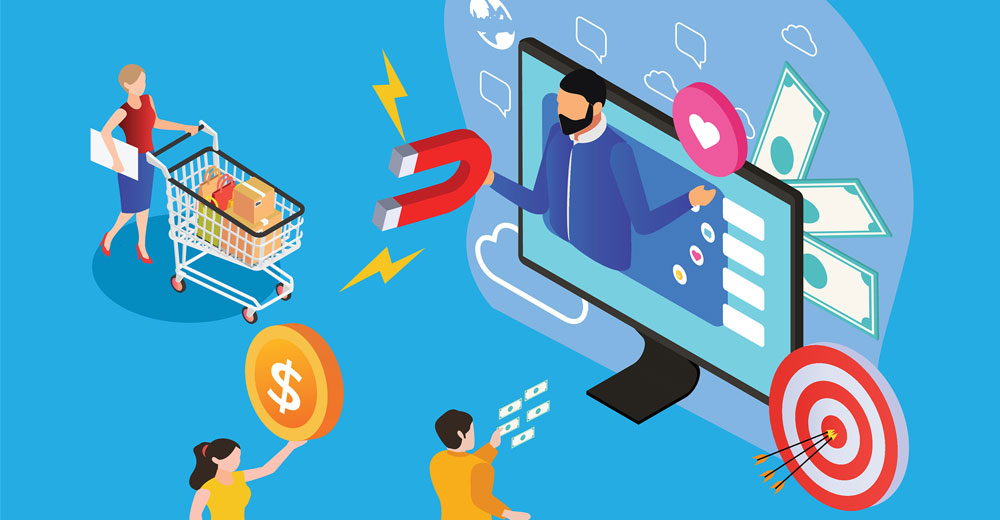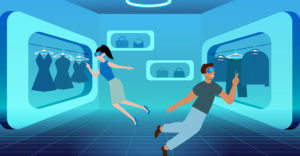In the past, e-commerce businesses have utilized site optimization and paid campaigns as primary means of revenue growth. Although this approach isn’t completely outdated, recent changes in consumer behavior, customer needs, and cost increases for paid advertisements have made the landscape of e-commerce marketing more complicated.
As far back as 2002, organic growth served as an important marketing strategy for e-commerce businesses. At the time, the competition on Google and other search engines was minimal. With the rising costs of paid advertising on Google, Facebook, Amazon, and other platforms that are popular for e-commerce, more companies are returning to the roots of e-commerce marketing by developing organic growth campaigns.
In other words, they’re turning to inbound marketing.
E-commerce marketing isn’t about choosing paid advertising over an inbound strategy. Instead, businesses should use the two to work in conjunction. In other words, paid media is putting the fuel on the fire — inbound is the steady burn.
What Is Inbound Marketing and Why Is It Important for E-Commerce Businesses?
According to HubSpot, “inbound marketing is a business methodology that attracts customers by creating valuable content and experiences tailored to them.”
Outbound marketing, in contrast, is interruptive, using marketing strategies that seek to obstruct potential customers.
Most importantly, inbound marketing focuses on the customer experience by following best practices that address customer needs. By providing a positive purchasing experience, those potential customers become customers who then become promoters of your brand.
So, why is this important for e-commerce businesses?
Inbound marketing seeks to understand the customer on multiple levels.
E-commerce is getting faster and more accessible, and purchasing is happening in an omnichannel world where businesses sell their products on popular marketplaces, such as Amazon, Facebook, Instagram, and Pinterest.
Plus, the way customers are purchasing is different. According to Insider Intelligence, sales of mobile devices during 2021 increased by 15.2% over 2020. By 2025, mobile sales are forecasted to double, reaching $728.28 billion, which would account for 44.2% of e-commerce retail sales in the U.S.
Understanding buying behaviors, demographics, and where the customer is buying can be answered with strategies at the core of inbound marketing.
The First Steps of an Inbound Marketing Strategy
From developing a product to acquiring new customers, to retaining those customers, e-commerce success starts and ends with understanding the customer.
Unfortunately, e-commerce businesses tend to overlook certain aspects of this. While it is common to know more general features of their target audience, most businesses neglect segmentation and personalization in favor of a more general understanding. This tends to create a cycle where customers interested in the brand aren’t receiving a personalized buying journey.
There are two steps to take to develop a personalized inbound marketing strategy:
1. Create buyer personas
Buyer personas are semifictional representations of ideal customers. They are created based on real data and educated speculation about a customer’s demographics, behaviors, motivations, and goals.
There are two main categories of the buyer persona that need to be answered:
- Customer information provides insight into demographics, interests, hobbies, behaviors, and lifestyles.
- Stage of the buying process allows marketers to categorize the audience into new and retained customers.
These attributes allow you to segment customers based on who they are and what their value is to your business.
2. Establish business goals and objectives
Inbound marketing KPIs measure and evaluate the success of an organization or employee in meeting performance objectives. For e-commerce businesses, marketing campaigns often emphasize financial growth and direct attribution.
E-commerce businesses most commonly track the following KPIs:
- Traffic source to the website
- Conversion rates
- Average order value
- Lifetime customer value
- Online revenue
- Cost of customer acquisition
- Time to purchase
- Purchase cycle
- Repeat purchase cycle
While the buyer personas and business goals might not seem to connect in an obvious way, the more personalized the marketing, the more likely you are to meet those business goals.
Common Inbound Strategies for E-Commerce Businesses
The inbound methodology is based on “the flywheel,” a concept popularized by HubSpot that categorizes marketing efforts into three stages: attract, engage, and delight.
E-commerce businesses can adapt their marketing efforts to the flywheel in the following ways:
Attract
The attract stage seeks to cast a wide net to attract new visitors to your website. You can generate awareness for lead generation by focusing on search engine optimization, blog content, video, user-generated content, social media, and paid media.
Search Engine Optimization
Search engine optimization (SEO) is a tactic based on technical and nontechnical strategies that can increase organic visibility. These include:
- Target keywords
- Character limits to URLs and meta descriptions
- Modifying words on product pages
- Image alt text
- Rich snippets that include product names and customer reviews
Content
Content can be considered the “nontechnical” side of SEO. When referring to content, marketers are usually talking about written content, such as blog posts, e-books, and pillar pages, that use an SEO strategy. But they can also be talking about video marketing.
Content is an important part of any long-term marketing strategy. Although the results are not immediate, the domain authority gained over time can move you up in search engine rankings.
Plus, the information creates trust, increases brand awareness and loyalty, and leads to more purchases.
User-Generated Content
User-generated content is usually reviews or ratings of a business or product. By adding reviews and ratings to a site and search engine page, businesses benefit from:
- Improved search engine ranking
- Increased traffic to a website
- Increased confidence in purchasing decisions
This is a small change that can influence conversion rate and customer satisfaction.
Social Media
Influencer marketing is increasingly becoming a part of e-commerce marketing efforts taking place on social media. But e-commerce companies can also utilize everyday customers by incentivizing social shares and creating flexible content guidelines that ensure the brand is represented correctly regardless of the channel.
Paid Media
As mentioned earlier, inbound marketing does not exclude paid media but rather works in conjunction with it. Common paid media strategies include:
- Paid search advertising
- Display advertising
- Social media advertising
These strategies can help attract new buyers and expand brand reach.
Engage
In the engage stage, marketers are focused on nurturing prospects and moving them toward a purchase.
Catalog Optimization
This is the process of analyzing, optimizing, and streamlining products to maximize revenue. This process also identifies which products aren’t selling well and reorients the marketing strategy around those products.
Identifying these categories provides a great opportunity for marketers to experiment with discounts or offers that help entice customers.
Email Marketing
Along with SMS messaging, email marketing is one of the most recognized forms of marketing to e-commerce marketers. Email is the highest converting channel and consistently drives revenue.
The quality of the campaigns can also be easily tested through A/B testing, where two versions of an email — or element of an email — are compared to determine the quality of performance. Not only does this help drive revenue, but it also impacts future approaches.
User Experience
Design thinking is becoming a mainstay in multiple industries that utilize the digital sphere. When it comes to e-commerce marketing, two main user experience elements need to be implemented:
- Site search: Customers need to easily be able to find the product they’re looking for. A site search function provides this.
- Chatbots and live chat: Responsive, directed customer service is required at any stage of the buying process.
Recovery Strategies
Cart abandonment happens when a customer places items in their cart but decides not to purchase. It’s incredibly common, with a nearly 70% abandonment rate.
Many marketers solve this issue with cart abandonment email workflows that include a series of emails that seek to reengage the customer with special offers and discounts.
Analytics
Inbound marketers are constantly looking at the data that comes through their efforts. It provides information on:
- Strategies that were successful and those that failed
- How the strategies are helping the company meet overall business goals and objectives
Delight
Finally, once you have converted potential customers into buyers, the delight stage begins and provides your company with a chance to shine.
Optimizing the customer experience can happen in many ways, such as shipping, having quality products, offering easy returns and exchanges, inviting customers to a community, providing helpful content, encouraging social sharing, and many more.
Personalization
Personalization is about adding value wherever you can. While it can look like offering discounts or coupons after a certain amount of purchases, personalization also taps into buyer personas. You don’t want to send emails promoting products to a segment of your audience that isn’t interested.
Every point of contact needs to lead back to these personas to create a highly personalized form of communication.
Reengagement Campaigns
Every e-commerce business experiences a quiet customer at some point. Unfortunately, finding new customers is more expensive than retaining existing customers.
If they haven’t purchased in some time, you’ll want to reengage the customer through email by promoting new products and events and offering discounts and coupons.
However, remember that it’s not uncommon for customers to come and go. If re-engagement isn’t working after a period of time, it’s time to move on so that you can focus more energy on existing customers.
Loyalty Programs
Keeping customers engaged can be accomplished through a tiered loyalty or VIP program. The more they spend, the more exclusive incentives open up. Some common incentives include discounts on birthdays or purchase anniversaries.
While these messages can be automated, they nonetheless have the potential to leave a lasting impact.
Inbound Marketing Is the Future of E-Commerce
While the e-commerce landscape is increasingly changing, implementing the inbound marketing strategies we’ve outlined will be helpful as you develop a long-term strategy based on organic growth, acquiring and retaining customers, and — most importantly — delighting them with content and stellar products.


















































Social Media
See all Social Media